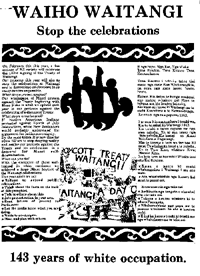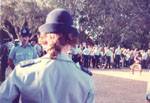Concerns
over land and other matters continued to be voiced by Maori in the 1980s.
The call was for greater Pakeha awareness and acceptance of Maoritanga,
seen as guaranteed by the treaty, and for acknowledgement of Maori as the
tangata whenua (people of the land). It was a move to emphasise the multicultural
aspect of national identity �  to
take in migration from the Pacific Islands � that raised the volume of Maori
protest and focused it. When officialdom began to use the treaty as the
unifying symbol of the emerging multicultural society, Maori suggested that
the government was avoiding grappling with treaty problems and the bicultural
partnership.
to
take in migration from the Pacific Islands � that raised the volume of Maori
protest and focused it. When officialdom began to use the treaty as the
unifying symbol of the emerging multicultural society, Maori suggested that
the government was avoiding grappling with treaty problems and the bicultural
partnership.
Maori opinion was divided, both on treaty issues and on Waitangi Day
events.  Activists
called for a boycott of Waitangi Day until the terms of the treaty were
'honoured', but there was no unified response. Tensions between activists
and older leaders were most obvious to the public at Te Tii marae. Northern
leaders had traditionally regarded the treaty as a covenant of a sacred
nature negotiated by their tupuna. In the annual marae discussions leading
up to Waitangi Day they showed marked resistance when younger speakers
branded the treaty as a �fraud'. The marae became a place of confrontation
between young and old, with marae trustees struggling to keep control.
In 1981 an honours investiture of Graham Latimer and the elderly Whina
Cooper at the marae was disrupted.
Activists
called for a boycott of Waitangi Day until the terms of the treaty were
'honoured', but there was no unified response. Tensions between activists
and older leaders were most obvious to the public at Te Tii marae. Northern
leaders had traditionally regarded the treaty as a covenant of a sacred
nature negotiated by their tupuna. In the annual marae discussions leading
up to Waitangi Day they showed marked resistance when younger speakers
branded the treaty as a �fraud'. The marae became a place of confrontation
between young and old, with marae trustees struggling to keep control.
In 1981 an honours investiture of Graham Latimer and the elderly Whina
Cooper at the marae was disrupted.
Each year problems of security on the treaty house grounds confronted
organisers. Larger numbers of police were required. Government representatives
and other speakers grew more cautious in talking of 'one people', but
commemoration  seemed
farcical when numerous police in riot gear were needed at the 1983 ceremony.
By then a sympathetic understanding of treaty issues was evident among
a widening circle of Pakeha (in part influenced by academic writing),
and church leaders were becoming reluctant to take part in Waitangi Day
ceremonies in the manner officially required.
seemed
farcical when numerous police in riot gear were needed at the 1983 ceremony.
By then a sympathetic understanding of treaty issues was evident among
a widening circle of Pakeha (in part influenced by academic writing),
and church leaders were becoming reluctant to take part in Waitangi Day
ceremonies in the manner officially required.
1984 was a watershed year. A hikoi (march) to Waitangi, organised in
protest against �celebrating' the day, included representatives of many
tribes, church leaders and some Pakeha. The impact of the protest was
blunted when Governor-General David Beattie, James Henare and Hiwi Tauroa
waited in vain for two hours to meet hikoi leaders. But the expression
of kotahitanga (oneness of purpose) was impressive, and two hui followed,
calling for a Maori consensus on the treaty and no further Waitangi �celebrations'
until the treaty had been �honoured' (a term much used thereafter).